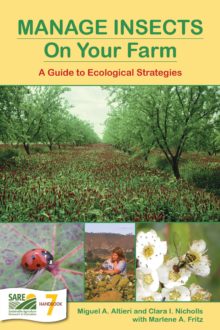Farm Feature: Resistant Fruit Varieties Reduce Risk
- Suppresses annual weeds with mulches
- Improves soils with animal manure
- Uses disease-resistant varieties
Wisconsin fruit grower Eric Carlson pays twice the price of conventional fertilizers to feed his half-acre of transitional-organic blueberries with composted poultry manure, augmented with elemental sulfur, potassium and magnesium. He calculates that those blueberries need a half-mile of weeding every two or three weeks — a full mile if you figure both sides. The semi-load of mulches he buys each year suppresses his annual weeds, but perennials like sorrel and quackgrass — the latter so tenacious he’s come to admire it — persist. At $8 an hour, Carlson’s hand weeding costs five to 10 times as much as herbicide treatments.
“I know what I’m getting into, so I’m starting small,” says Carlson. Fortunately, he has an urban customer base willing to pay what it costs to grow organic lueberries.
Because Carlson sells 95 percent of his fruit right on his Bayfield County farm — 70 percent of it pick-your-own — he also has customers eager to sample novel scab-resistant apples like Jonafrees, Redfrees, Priscillas, Pristines and Liberties. He doubts that would be case if he were selling his apples wholesale. Fortunately, his direct-market emphasis allows Carlson to take risks growing diverse varieties that other producers would be reluctant to try.
Carlson, who earned dual bachelor’s degrees in horticulture and agronomy from the University of Wisconsin in 1983, first began following his dreams in 1989. That’s when he left a seven-year job at the UW fruit pathology laboratory to grow his own hardy blueberries. Reared in the Milwaukee suburb of Wauwatosa, he chose 40 “exceptionally beautiful” acres on a finger of northern Wisconsin that juts into Lake Superior. Gradually, he expanded to 3 acres of blueberries, 1½ acres of raspberries, an acre of fresh-cut and everlasting flowers and 1,200 apple trees.
Economic sustainability comes first
Environmental sustainability has been an objective of Carlson’s enterprise from the beginning. “We wanted people to come here, enjoy the environment and be able to walk around and buy healthy food,” he says. However, financial reality quickly earned equal billing.
“You have to make the system economically sustainable first and then use the tools that are available to you to make it environmentally sustainable,” says Carlson. “That’s always been a struggle for me. My ideal is not using any synthetic chemicals, but I need to stay in business.”
That’s why Carlson now sparingly uses malathion to stop leafhoppers from infecting his flowers with aster yellows disease, which they can briskly do within 24 hours. With about a fifth of his 250 flower species susceptible to the plant-killing virus, Carlson scouts his fields daily when his climate is ripe for leafhoppers, spraying once or twice if he must.
It’s also why he has adopted a “low-spray” program for his apples, treating them conservatively with the relatively short-lived organophosphate Imidan: twice around petal-fall for plum curculio and codling moth and about twice after petal-fall for apple maggot flies. “I feel like it’s the least amount that I can put out there and still have a marketable crop,” he says. He times his apple maggot sprays with red visual traps.
Alternative disease management slashes fungicide use
For two years, Carlson cooperated with UW researchers as they built a predictive model for apple scab around measurements of air temperatures and leaf surface moisture. Some years, he uses only half as many fungicides as conventional growers do on his three scab-susceptible apple varieties — Cortland, Gala and Sweet 16 — while other years he can eliminate only one or two treatments.
On his 1,000 scab-resistant trees, which outnumber his susceptible trees five-fold, Carlson applies no fungicides at all. During the growing season, he quickly cuts out branches showing the earliest signs of fireblight and, during the dormant season, he aggressively prunes any possibly overwintering cankers. “Typically, apple growers spray tank mixtures of fungicides plus insecticides,” says Carlson. “On my scab-resistant block, I’m not putting fungicides into the tank, so I feel good about that.”
Carlson planted his apples densely — and consequently more expensively — on dwarfing rootstocks. That has allowed him to respond more nimbly to changing consumer tastes, since trees on dwarf rootstocks typically start bearing in two years rather than five. While his customers like learning that their apples were grown without fungicides, Carlson knows that flavor is what sells fruit and that consumer preferences can rival aroma compounds for volatility.
Rested raspberries reward their producers
Carlson is also experimenting with alternate-row production in raspberries. By mowing every other row of his berries, he hopes to significantly reduce fungicide applications and to use preemergence herbicides only once every three or four years. “You would think you would also cut your yields in half, but that’s not necessarily the case,” he says. “Because of how well the plant responds to a rest year, the research shows that you can get up to 75 percent of your normal production.”
According to Carlson, a plethora of cane diseases make raspberries difficult to raise organically, so he grows them with what he calls a “basically conventional IPM approach.” He trickle-irrigates them and makes sure 1½ to 2 feet of circulation-enhancing space separates his plants, minimizing the odds of raspberry disease.
After almost 15 years as an agricultural entrepreneur, Carlson likens fruit crops to “waves coming into shore.” They don’t produce harvests immediately but, like those waves, they “will come in the long run.” Although working for himself — and for the health of his customers and the environment — is less predictable than his old university paycheck, Carlson makes sure he’s still waiting on the shore by keeping his risks manageable.
